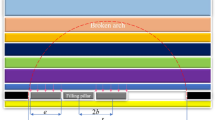Abstract
Many mined-out voids pose a great threat to engineering construction in China. To prevent the potential surface deformation caused by mined-out voids collapse, filling material treatment methods such as liquid cement slurry, mixture with different proportion of cement and fly ash, mixture with different proportion of cement and clay are used. In recent years, the super-high-water material has been widely adopted. However, few studies have been carried out to examine the treatment quality using super-high-water material. In this study, a case of the application of super-high-water material in treatment of mined-out voids was firstly presented and then the treatment quality was examined by geophysical transient electromagnetic method (TEM). In order to study the feasibility of TEM, 1D forward modeling was used to obtain the TEM response curves before and after filling and obvious differences were observed. After filling, the max amplification of secondary field-induced voltage would be about 40 or 100% depending on whether underground mined-out voids had been water-accumulating or not before; the corresponding apparent resistivity would decrease more than 20% after filling. The practice at a coalmine located in northern China showed that the change features of apparent resistivity between before and after filling coincided with the modeling; the effective filled area inferred by the boundary whose apparent resistivity had decreased more than 20% was basically accurate, which clearly indicates that the filling mined-out voids using super-high-water material was feasible and effective.










Similar content being viewed by others
References
Christiansen AV, Auken E, Sørensen K (2006) The transient electromagnetic method, pp 179–225. In: Kirsch R (ed) Groundwater geophysics, a tool for hydrologists. Springer, Berlin, p 493
Danielsen JE, Auken E, Jørgensen F, Søndergaard V, Sørensen KI (2003) The application of the transient electromagnetic method in hydrogeophysical surveys. J Appl Geophys 53:181–198
Ding Y, Feng G, Wang C (2011) Experimental research on basic properties of super-high-water packing material. J China Coal Soc 36(7):1087–1092
Feng G, Sun C, Wang C et al (2010a) Research on goaf filling method with super-high-water material. J China Coal Soc 35(12):1963–1968
Feng G, Ding Yu, Zhu H, Bai J (2010b) Experimental research on a super high-water packing material for mining and its micromorphology. J China Univ Min Technol 39(6):813–819
Feng G, Jia K, Shang B (2015) Application and prospect of super-high-water packing material in mining engineering. Coal Sci Technol 43(1):5–9
Fitterman DV, Stewart MT (1986) Transient electromagnetic sounding for groundwater. Geophysics 51:995–1005
Kaufman AA, Keller GV (1983) Frequency and transient sounding. Elsevier, London
Li H, Guo G, Zhai S (2016) Mining scheme design for super-high water backfill strip mining under buildings: a Chinese case study. Environ Earth Sci 75:1017. doi:10.1007/s12665-016-5837-5
Liu H, Lei S, Deng K et al (2014) Research on ground fissure treatment filling with super-high-water material. J China Coal Soc 39(1):72–77
Nabighian MN (1979) Quasi-static transient response of a conducting half-space-an approximate representation. Geophysics 44:1700–1705
Spies BR (1989) Depth of investigation in electromagnetic sounding method. Geophysics 54:872–888
Xue GQ, Yan YJ, Cheng JL (2011) Researches on detection of 3-D underground cave based on TEM technique. Environ Earth Sci 64:425–430
Xue GQ, Cheng JL, Zhou NN, Chen WY, Li H (2013) Detection and monitoring of water-filled voids using transient electromagnetic method: a case study in Shanxi, China. Environ Earth Sci 70:2263–2270
Zhu WD, Zhang YG (2008) Study on the application of transient electromagnetic method to the detection of underground cave. Build Tech Dev 11:73–76
Acknowledgements
This project was supported by the National Natural Science Foundation of China (Project No. 51674142) and National Science and Technology Major Project of the Ministry of Science and Technology of China (Project No. 2016ZX05045001-004).
Author information
Authors and Affiliations
Corresponding author
Rights and permissions
About this article
Cite this article
Li, H., Zhang, Y., Xu, L. et al. Examination of the treatment quality of filling mined-out voids using super-high-water material by the TEM technique. Environ Earth Sci 76, 115 (2017). https://doi.org/10.1007/s12665-017-6431-1
Received:
Accepted:
Published:
DOI: https://doi.org/10.1007/s12665-017-6431-1




